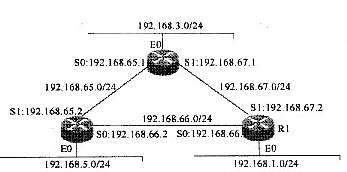问题
单项选择题
某城域网拓扑结构如下图所示。如果该路由器R1接收到一个源IP地址为192.168.1.10、目的IP地址为192.168.3.20的IP数据报,那么它将把此IP数据报投递到U地址为()的路由器端口上。

A.192.168.66.1
B.192.168.66.2
C. 192.168.67.1
D.192.168.67.2
答案
参考答案:C
解析:
在图中所示的城域网拓扑结构中,路由器R1接收到一个源IP为192.168.1.10。目的IP地址为192.168.3.20的IP数据报。其中,192.168.1.10属于192.168.1.0/24网段的IP地址,即该IP数据报来源于路由器R1的E0端口;192.168.3.20属于192.168.3./24网段的IP地址,因此路由器R1将把此IP数据报投递到D地址为192.168.67.1的路由器端口上,即该IP数据报将从路由器R1的S1端口投递给下一个邻居路由器。该邻居路由器将从IP地址为192.168.67.1的S1端口接收到此数据报。可见IP地址192.168.67.1是源IP地址为192.168.1.10。目的U地址为192.168.1.20的IP数据报的下一跳路由地址。
